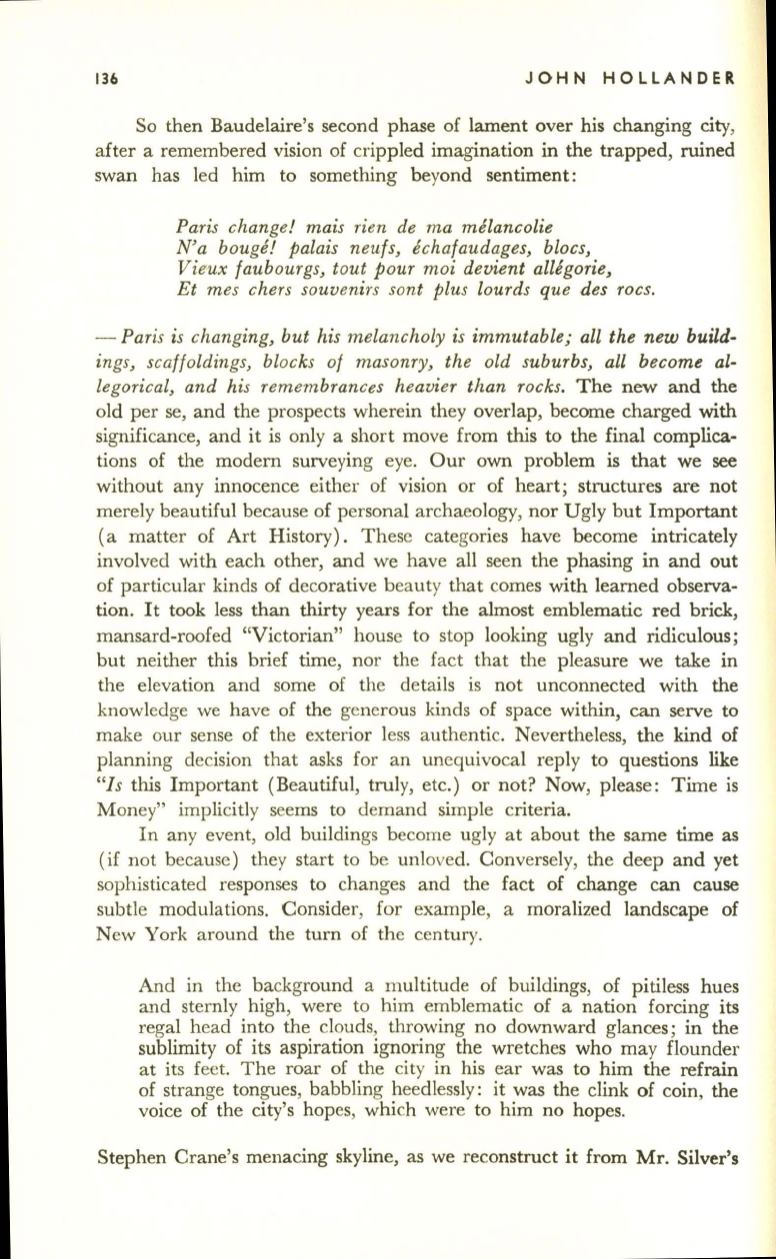
136
JOHN HOLLANDER
So then Baudelaire's second phase of lament over his changing city,
after a remembered vision of crippled imagination
in
the trapped, ruined
swan has led him to something beyond sentiment:
Paris change! mais rien de ma melancolie
N'a bouge! palais neufs, echafaudages, blocs,
Vieux faubourgs, tout pour moi devient allegorie,
Et mes chers souvenirs sont plus lourds que des roes.
- Paris is changing, but his melancholy is immutable; all the new build–
ings, scaffoldings, blocks of masonry, the old suburbs, all become al–
legorical, and his remembrances heavier than rocks.
The new and the
old per se, and the prospects wherein they overlap, become charged with
significance, and it is only a short move from this to the final complica–
tions of the modem surveying eye. Our own problem
is
that we see
without any innocence either of vision or of heart; structures are not
merely beautiful because of personal archaeology, nor Ugly but Important
(a matter of Art History). These categories have become intricately
involved with each other, and we have all seen the phasing
in
and out
of particular kinds of decorative beauty that comes with learned observa–
tion. It took less than thirty years for the almost emblematic red brick,
mansard-roofed "Victorian" house to stop looking ugly and ridiculous;
but neither this brief time, nor the fact that the pleasure we take in
the elevation and some of the details is not unconnected with the
knowledge we have of the generous kinds of space within, can serve to
make our sense of the exterior less authentic. Nevertheless, the kind of
planning decision that asks for an unequivocal reply to questions like
"Is
this Important (Beautiful, truly, etc.) or not? Now, please: Time is
Money" implicitly seems to demand simple criteria.
In any event, old buildings become ugly at about the same time as
(if not because) they start to be unloved. Conversely, the deep and yet
sophisticated responses to changes and the fact of change can cause
subtle modulations. Consider, for example, a moralized landscape of
New York around the turn of the century.
And in the background a multitude of buildings, of pitiless hues
and sternly high, were to him emblematic of a nation forcing its
regal head into the clouds, throwing no downward glances; in the
sublimity of its aspiration ignoring the wretches who may flounder
at its feet. The roar of the city in his ear was to him the refrain
of strange tongues, babbling heedlessly: it was the clink of coin, the
voice of the city's hopes, which were to him no hopes.
Stephen Crane's menacing skyline, as we reconstruct it from Mr. Silver's


